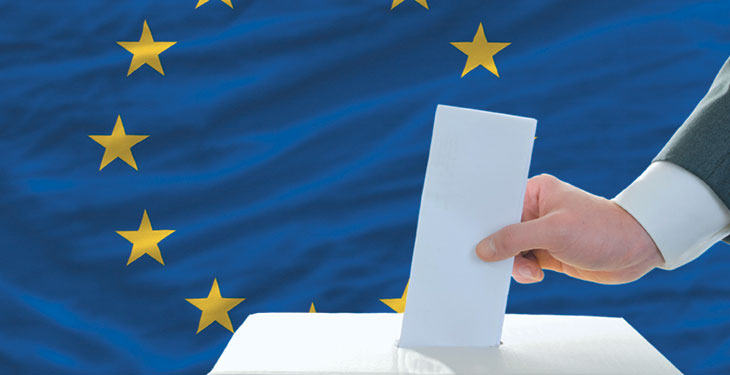Between May 23rd and 26th, over 400 million European citizens will vote to establish the structure of the future European Parliament for the next five years. It will be the first major test for the EU leadership gathered in Sibiu on May 9 – citizens will confirm that they adhere to the principles included in the Sibiu Declaration. Or not.
The decision-making process within the European Union is extremely complex and difficult, with three institutions that need to agree on almost every subject: The European Commission, the Council of the European Union and the European Parliament. This makes it hard to anticipate when and in which form an important decision will be adopted. European elections represent the stepping stone and the foundation of credibility and legitimacy for all three institutions.
The popular vote decides the number of MEPs from each national party, which are (generally) part of an European political family. The European Parliament decides on the structure of the European Commission and then becomes an essential part of the co-decision process.
Why do European elections matter?
The first hint regarding the future national political configuration Romania will have four rounds of elections in a two-years interval; the European elections (May 26th, 2019), are followed by presidential elections (December 2019), local elections (2020) and then parliament elections (March 2021 at the latest). The results of the May 2019 elections will offer the first relevant image of the political spectrum in Romania, after two years of reconfiguration, both at party level and in terms of voters’ options. PSD, the grand winner of the 2016 vote seems to be worn down strongly during the past years. ALDE, PSD’s government partner is one of those benefiting from this wear and appears in polls stronger than two years ago. The main opposition party, PNL, has an additional 25% compared to its score in 2016. The great variable here is the evolution of the newly established alliance between USR and PLUS, one of the players from outside the traditional political groups. The Pro România Party, led by the former PSD leader Victor Ponta and built based on a core composed of former important members of PSD, is also credited with an excellent score for a newly formed political assembly (around 8%).
The results of the May 2019 vote might lead to the revaluation of both leaders (L. Dragnea, in PSD, Ludovic Orban, in PNL), and of certain alliances, namely the relations between ALDE and PSD. This might lead to certain changes, even in the structure and coloring, ideologies and fidelity of the Government and Parliament.
New Romanian representatives in the European Parliament The direct result of the May vote is the establishment of the persons who will compose the group of 33 Romanian MEPs in Brussels and Strasbourg. Most likely, PSD will manage to send at least 10 representatives to the European body, PNL will increase its presence from 6 to 9 politicians, while the other parties or alliances listed as having chances will have between 3 and 6 representatives. The persons are in many situations known, following the completion of the parties’ internal lists; they are the ones who will represent Romania’s interests in the debates of the European Parliament for the following 5 years.
A new configuration of the European political forces Most analysts believe that the 2019 vote is the most important one in the past few decades. Polls identify a record level of support granted by European citizens to the EU: 67% of citizens considered in 2018 that their country has benefited from their country’s EU membership, being the highest percentage since 1983. At the same time, the steady advance of Euroscepticism, even though slower than anticipated, will lead, most likely, to a historical reconfiguration of the UE political dynamics.
ALSO READ The EU is about to define itself a new strategic vision
For many decades, the great European political families of center-right (PPE) and center-left (S&D) have held comfortable majorities in the main institutions of the EU, the Parliament, the Council and the Committee. This tradition might fall apart in 2019, since it is anticipated that the mainstream parties will lose ground massively in favor of the populist groups, coming from both radical right and radical left, and of the new political actors.
Even in the likely case that the main European projects will be maintained – especially the adherence to environmental protection and to the strengthening of the internal market –, it is likely for the debates of the European decision-making bodies to be more complicated and lengthier, and for the decisions to result from ad-hoc alliances, more often than from the decisions negotiated by the great European parties.
All of this is relevant for Romania, for companies, authorities and citizens alike, considering the fact that European decisions are also applied here, sometimes directly, other times with a slight delay, in almost all fields, from agriculture, to energy and environment, from transportation to industry, commerce, the banking sector, telecommunications and tourism.
Politicians prepare for Romania’s 3rd round of European elections
Romania joined the EU on January 1, 2007. Since then, it has economic recession in two years and growth in the other 10. Romanians sent to the European Parliament representatives of 8 parties and 2 wo independents. PSD, in alliances with other groups, won both the previous rounds.
This year, two new born parties (USR and PLUS, most likely in an alliance) will enter the EP; two other parties have also chances, both animated by former members of the main traditional parties: Pro Romania, detached from PSD, respectively ALDE, split from PNL.
—————————————-
This article firstly appeared in the printed edition of energynomics.ro Magazine, issued in March 2019.
In order to receive the printed or electronic this issue of energynomics.ro Magazine, we encourage you to write us at office [at] energynomics.ro to include you in our distribution list. All previous editions are available HERE.
